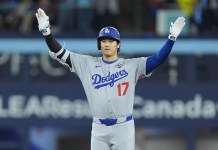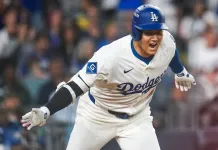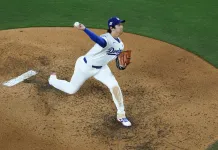The last time the San Diego Padres made it to the NLCS, they also made it to the World Series. That season was 1998 and the Friars upset the heavily-favored Atlanta Braves to earn a date with the heavily-favored New York Yankees. The Yankees would ultimately sweep that series, and the Padres hadn’t been back to the LCS since. They’re back this year, and even have home-field advantage against the Philadelphia Phillies.
The Phillies are back in the LCS for the first time since 2010 when they fell to the eventual World Series Champion San Francisco Giants in six games. The Phillies made the playoffs the next season, but 2011 was the end of a truly impressive run with five straight playoff appearances, league pennants in 2008 and 2009 and a World Series title in those ’09 playoffs.
Both teams have certainly earned their way here, as the Phillies took out two division champs in the Cardinals and Braves, while the Padres beat two of the league’s four 100-win teams with upsets over the Mets and Dodgers. Now, they match up head-to-head for the right to go to the World Series.
Philadelphia Phillies (%plussign% 105) vs. San Diego Padres (-120)
Depth will be the key to this series. There are some superstars and some excellent players on both rosters, but the best-of-seven format can expose teams more than a best-of-three or a best-of-five. In this series, both teams look prepared to use their fourth starters, an advantage that I believe should go to the Padres. You also must be more economical with your bullpen, another advantage that looks to go to the Padres.
One other advantage that rests with San Diego is on defense. The Phillies would love to be able to use three designated hitters, as Kyle Schwarber and Nick Castellanos are about as bad as it gets defensively. Brandon Marsh has at least been a league average defender in center field and Bryson Stott has been a little better at shortstop than Didi Gregorius. However, this is still a Phillies team that ranked 25th in Defensive Runs Saved and the all-encompassing Def metric at FanGraphs.
The Padres finished the regular season 11th in Def, 18th in DRS, and third in Outs Above Average (per Statcast); the Phillies ranked 29th in Outs Abover Average. We’re talking about a difference of nearly 70 outs between the two teams defensively. To that end, that’s where the starting pitcher depth comes into play. All of San Diego’s starters have strikeout upside, while Ranger Suarez and Noah Syndergaard are cut from the pitch-to-contact cloth.
However, the long ball is the great equalizer and the Phillies have hit a lot of multi-run homers at very important times to this point. Philadelphia has averaged over five runs per game against the Cardinals and Braves, two teams that were rather stingy during the regular season and both defend very well. Philadelphia’s low K% has also been a key, as they’ve managed to put a lot of balls in play in the high-strikeout, low-scoring environment.
The Phillies have struck out just 49 times in 222 plate appearances (22%), while the Padres have struck out 76 times in 264 plate appearances (28.8%). Of course, San Diego has faced the Mets and Dodgers, who had arguably the two best pitching staffs during the postseason. Philadelphia faced a pitch-to-contact staff against the Cardinals that ranked 28th in K%.
Nevertheless, the Phillies have gotten some big blows at important times and that’s one the reasons why they’re here. Philadelphia’s bullpen was also solid aside from Atlanta’s ninth-inning comeback attempt against Zach Eflin in Game 1. They’ve allowed just 10 runs on 16 hits in 21.2 innings with 29 strikeouts. That Eflin inning with three runs bumps the ERA from 3.05 to 4.15, so it was certainly a big one in the small sample.
Once again, though, the bullpen feels like another area where the Padres are better. Their pen has only allowed six runs on 12 hits in 24.2 innings with 28 strikeouts across seven games. The Padres’ ability to keep the Dodgers from capitalizing on their chances with runners in scoring position is why that series played out the way that it did. If guys like Robert Suarez and Nick Martinez can keep doing that as the bridge to Josh Hader, San Diego is in good shape here. Hader finding his lost form has been a huge storyline of the latter part of the season.
Aaron Nola and Zack Wheeler have to be really good for the Phillies in this series. Nola has allowed one unearned run over his 12.2 innings with huge efforts in both of his Game 2 starts. Wheeler has allowed three runs on six hits in 12.1 innings of work. He’s gotten a bit unlucky, as none of the six hits were homers, but that’s one of the concerning things about the Phillies defense.
The Padres have gotten strong returns from Yu Darvish and Joe Musgrove, as they’ve combined for four starts with six runs allowed on 20 hits in 25 innings of work. Blake Snell has only allowed three runs, but has allowed 17 baserunners in his 8.2 innings of work. He’s the guy to worry about here because the Phillies had a top-five offense against left-handed pitching. They were much closer to league average against righties.
Personally, I’d be more inclined to send out Mike Clevinger (despite his struggles against LA) in Game 3 and maybe piggyback him with Snell, but I do approve of the Padres sending out Darvish and Musgrove for Games 1 and 2. The Phillies are able to send out Wheeler and Nola for the two games at Petco Park and the travel day after Game 2 means that all of those guys will be on regular rest for Games 5 and 6.
On a game-by-game basis, you have a lot less familiarity between these two teams. In the previous series, the teams had 19 head-to-head games, so they knew each other’s tendencies and had seen the pitch design and pitch shape from the guys that they were facing. This series has a little bit more of a learning curve to it with teams that only played seven games head-to-head during the regular season. I’m not overly surprised that the average runs scored per game was just 5.14.
At the current series price, I like the Padres at -120. Like I said, the LCS requires you to be a deeper team because you go further into the rotation and further into the bullpen. Those are two areas where I give San Diego the edge. They are also the better defensive team, which may play a larger role over a slightly bigger sample size.
I also think that they win Game 1. Had Nola and Wheeler been flipped, I feel like Nola has more upside and that may have skewed my opinion a bit. I think if you like the Phillies, you may want to take them going into Game 2 with Nola on the hill, where they could head home with a split. As things stand, I think the Padres, who are -120 to -125 for Game 1, do draw first blood.
Pick: Padres to win series (-120)





